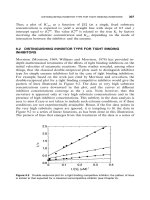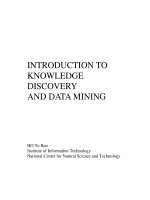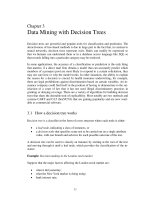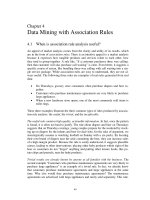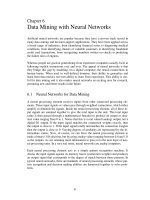Lecture Introduction to Machine learning and Data mining: Lesson 9.2
Bạn đang xem bản rút gọn của tài liệu. Xem và tải ngay bản đầy đủ của tài liệu tại đây (945.59 KB, 20 trang )
Introduction to
Machine Learning and Data Mining
(Học máy và Khai phá dữ liệu)
Khoat Than
School of Information and Communication Technology
Hanoi University of Science and Technology
2022
Content
¡ Introduction to Machine Learning & Data Mining
¡ Unsupervised learning
¡ Supervised learning
Ă Probabilistic modeling
ă
Expectation maximization
Ă Practical advice
2
Difficult situations
¡ No closed-form solution for the learning/inference problem?
(khơng tìm c ngay cụng thc nghim)
ă
ă
The examples before are easy cases, as we can find solutions in a closed
form by using gradient.
Many models (e.g., GMM) do not admit a closed-form solution
¡ No explicit expression of the density/mass function?
(khơng có cơng thức tường minh để tính tốn)
¡ Intractable inference (bài tốn khơng kh thi)
ă
Inference in many probabilistic models is NP-hard
[Sontag & Roy, 2011; Tosh & Dasgupta, 2019]
3
4
Expectation
maximization
The EM algorithm
5
GMM revisit
q
q
Consider learning GMM, with K Gaussian distributions, from the training
data D = {x1, x2, …, xM}.
The density function is 𝑝(𝒙|𝝁, 𝜮, 𝝓) = ∑$
!"# 𝜙! 𝒩 𝒙 𝝁! , ! )
ă
ă
= (! , , " ) represents the weights of the Gaussians, 𝑃 𝑧 = 𝑘| 𝝓 = 𝜙# .
Each multivariate Gaussian has density
!
!
𝒩 𝒙 𝝁# , 𝜮# ) =
exp − ( 𝒙 − 𝝁#
$%&(()𝜮! )
q
, -!
𝜮#
𝒙 − 𝝁#
MLE tries to maximize the following log-likelihood function
&
$
𝐿 𝝁, 𝜮, 𝝓 = / log / 𝜙! 𝒩 𝒙% 𝝁! , 𝜮! )
%"#
!"#
q
We cannot find a closed-form solution!
q
Naïve gradient decent: repeat until convergence
ă
Optimize , , w.r.t , when fixing (, ).
ă
Optimize , , w.r.t (, ), when fixing 𝝓.
Still hard
6
GMM revisit: K-means
q
GMM: we need to know
ă
ă
q
Among K gaussian components,
which generates an instance x?
the index z of the gaussian component
𝑃(𝑧|𝒙, , , )?
(note
$
!"# (
K-means:
ă
The parameters of individual gaussian
components: # , # , #
Idea for GMM?
ă
q
ă
q
ă
= |, , , ) = 1)
Update the parameters of individual
gaussians: 𝝁# , 𝜮# , 𝜙#
The parameters of individual
clusters: the mean
K-means training:
Step 1: assign each instance
x to the nearest cluster
(the cluster index z for each x)
(hard assignment)
(soft assignment)
ă
Among K clusters, to which an
instance x belongs?
the cluster index z
ă
Step 2: recompute the means
of the clusters
7
GMM: lower bound
q
Idea for GMM?
ă
Step 1: compute (|, , , 𝝓)? (note ∑$!"# 𝑃(𝑧 = 𝑘|𝒙, 𝝁, 𝜮, 𝝓) = 1)
ă
Step 2: Update the parameters of the gaussian components: = 𝝁, 𝜮, 𝝓
¡ Consider the log-likelihood function
0
"
𝐿 𝜽 = log 𝑃(𝑫|𝜽) = : log : 𝜙# 𝒩 𝒙. 𝝁# , # )
./!
#/!
ă
Too complex if directly using gradient
ă
Note that log 𝑃(𝒙|𝜽) = log 𝑃(𝒙, 𝑧|𝜽) − log 𝑃(𝑧|𝒙, 𝜽). Therefore
log 𝑃(𝒙|𝜽) = 𝔼'|𝒙,𝜽 log 𝑃 𝒙, 𝑧 𝜽 − 𝔼'|𝒙,𝜽 log 𝑃 𝑧 𝒙, 𝜽 ≥ 𝔼'|𝒙,𝜽 log 𝑃 𝒙, 𝑧 𝜽
¡ Maximizing 𝐿(𝜽) can be done by maximizing the lower bound
𝐿𝐵 𝜽 = / 𝔼'|𝒙,𝜽 log 𝑃 𝒙, 𝑧 𝜽 = /
𝒙∈𝑫
𝒙∈𝑫
/ 𝑃 𝑧 𝒙, 𝜽 log 𝑃 𝒙, 𝑧 𝜽
'
GMM: maximize the lower bound
ă
Step 1: compute (|, , , 𝝓)? (note ∑$!"# 𝑃(𝑧 = 𝑘|𝒙, 𝝁, 𝜮, 𝝓) = 1)
ă
Step 2: Update the parameters of the gaussian components: = 𝝁, 𝜮, 𝝓
¡ Bayes’ rule: 𝑃 𝑧 𝒙, 𝜽 = 𝑃 𝒙 𝑧, 𝜽 𝑃(𝑧|𝝓)/𝑃(𝒙) = 𝜙' 𝒩 𝒙 𝝁' , 𝜮' )/𝐶,
where 𝐶 = ∑# 𝜙# 𝒩 𝒙 # , # ) is the normalizing constant.
ă
Meaning that one can compute , if is known
ă
Denoting 𝑇#. = 𝑃 𝑧 = 𝑘 𝒙. , 𝜽 for any index 𝑘 = 1, 𝐾, 𝑖 = 1, 𝑀
¡ How about ?
ă
1 = = 𝜽 = ∫ 𝑃 𝑧, 𝒙 𝜽 𝑑𝒙 = ∫ 𝑃 𝑧 𝒙, 𝜽 𝑃 𝒙 𝜽 𝑑𝒙 =
𝔼𝒙 𝑃 𝑧 𝒙, 𝜽 ≈ #" ∑𝒙∈4 𝑃 𝑧 𝒙, 𝜽 = #" ∑0
./! 𝑇1.
¡ Then the lower bound can be maximized w.r.t individual (𝝁! , 𝜮! ):
𝐿𝐵 𝜽 = :
0
"
𝒙∈𝑫
= : : 𝑇#. −
./! #/!
: 𝑃 𝑧 𝒙, 𝜽 log[𝑃 𝒙 𝑧, 𝜽 𝑃 𝑧 𝜽 ]
1
1
𝒙 − 𝝁#
2 .
, -!
𝜮#
𝒙. − 𝝁# − log det(2𝜋𝜮# ) + 𝑐𝑜𝑛𝑠𝑡𝑎𝑛𝑡
8
9
GMM: EM algorithm
¡ Input: training data 𝑫 = {𝒙1, 𝒙2, … , 𝒙𝑀 }, 𝐾 > 0
¡ Output: model parameter , ,
Ă Initialize
ă
.
, (.) , (.) randomly
(&) must be non-negative and sum to 1.
Ă At iteration :
ă
(9)
(9)
(9)
E step: compute 𝑇#. = 𝑃 𝑧 = 𝑘 𝒙. , 𝜽(9) = 𝜙# 𝒩 𝒙 𝝁# , 𝜮# )/𝐶
for any index 𝑘 = 1, 𝐾, 𝑖 = 1, 𝑀
M step: update for any k,
0
𝑎#
(9:!)
𝜙#
=
,
where 𝑎# = : 𝑇#. ;
𝑀
./!
0
0
1
1
(9:!)
(9:!)
(9:!)
𝝁#
=
: 𝑇#. 𝒙. ; #
=
: #. . #
#
#
./!
./!
ă
Ă If not convergence, go to iteration 𝑡 + 1.
𝒙. −
(9:!) ,
𝝁#
10
GMM: example 1
¡ We wish to model the height of a person
ă
We had collected a dataset from 10 people in Hanoi + 10 people in Sydney
D={1.6, 1.7, 1.65, 1.63, 1.75, 1.71, 1.68, 1.72, 1.77, 1.62, 1.75, 1.80, 1.85,
1.65, 1.91, 1.78, 1.88, 1.79, 1.82, 1.81}
GMM with
2 components
GMM with
3 components
11
GMM: example 2
¡ A GMM is fitted in a 2-dimensional dataset to do clustering.
From initialization
To convergence
/>
GMM: comparison with K-means
q
K-means:
ă
ă
q
Step 1: hard assignment
GMM clustering
ă
Step 2: the means
similar shape for the clusters?
12
ă
Soft assignment of data to the clusters
Parameters 𝝁# , 𝜮# , 𝜙#
àdifferent shapes for the clusters
/>
General models
13
¡ We can make the EM algorithm in more general cases.
¡ Consider a model 𝐵(𝒙, 𝒛; 𝜽) with observed variable x, hidden variable z,
and parameterized by 𝜽
(mơ hình có một biến x quan sát được, biến ẩn z, và tham s )
ă
ă
x depends on z and , while z may depend on 𝛉
Mixture models: each observed data point has a corresponding latent variable,
specifying the mixture component which generated the data point
¡ The learning task is to find a specific model, from the model family
parameterized by 𝜽, that maximizes the log-likelihood of training data D:
𝜽∗ = argmax𝜽 log 𝑃(𝑫|𝜽)
¡ We assume D consists of i.i.d samples of x, the the log-likelihood function
can be expressed analytically, 𝐿𝐵 𝜽 = ∑𝒙∈𝑫 𝔼'|𝒙,𝜽 log 𝑃 𝒙, 𝑧 𝜽 can be
computed easily (hàm log-likelihood cú th vit mt cỏch tng minh)
ă
Since there is a latent variable, MLE may not have a close form solution
The Expectation Maximization algorithm
14
¡ The Expectation maximization (EM) algorithm was introduced in 1977 by
Arthur Dempster, Nan Laird, and Donald Rubin.
¡ The EM algorithm maximizes the lower bound of the log-likelihood
L 𝜽; 𝑫 = log 𝑃 𝑫 𝜽 ≥ 𝐿𝐵 𝜽 = / 𝔼'|𝒙,𝜽 log 𝑃 𝒙, 𝑧 𝜽
𝒙∈𝑫
¡ Initialization: 𝜽(.) , = 0
Ă At iteration :
ă
E step: compute the expectation 𝑄 𝜽|𝜽(9) = 𝐿𝐵 𝜽(9-!)
(tính hàm kỳ vọng Q khi cố định giá trị 𝜽(() đã biết ở bước trc)
ă
M step: find (9:!) = argmax |(9)
(tỡm im (()#) mà làm cho hàm Q đạt cực đại)
¡ If not convergence, go to iteration 𝑡 + 1.
EM: covergence condition
¡ Different conditions can be used to check convergence
ă
does not change much between two consecutive iterations
ă
does not change much between two consecutive iterations
¡ In practice, we sometimes need to limit the maximum number of
iterations
15
16
EM: some properties
¡ The EM algorithm is guaranteed to return a stationary point of the lower
bound 𝐿𝐵 𝜽
(thuật toán EM đảm bảo sẽ hội tụ về một điểm dừng của hm cn di)
ă
It may be the local maximum
Ă Due to maximizing the lower bound, EM does not necessarily returns
the maximizer of the log-likelihood function
(EM chưa chắc trả về điểm cực i ca hm log-likelihood)
ă
ă
No guarantee exists
It can be seen in cases of multimodel,
where the log-likelihood function is non-concave
¡ The Baum-Welch algorithm is the a special
case of EM for hidden Markov models
multimodel
distribution
EM, mixture model, and clustering
17
¡ Mixture model: we assume the data population is composed of K
different components (distributions), and each data point is generated
from one of those components
ă
ă
E.g., Gaussian mixture model, categorical mixture
model, Bernoulli mixture model,…
The mixture density function can be written as
"
𝑓(𝒙; 𝜽, 𝝓) = : 𝜙# 𝑓# 𝒙 𝜽# )
#/!
where 𝑓# 𝒙 𝜽# ) is the density of the k-th component
¡ We can interpret that a mixture distribution partitions the data space
into different regions, each associates with a component
(Một phân bố hỗn hợp tạo ra một cách chia không gian dữ liệu ra thành các
vùng khác nhau, mà mỗi vùng tương ứng với 1 thành phần trong hỗn hợp đó)
¡ Hence, mixture models provide solutions for clustering
¡ The EM algorithm provides a natural way to learn mixture models
EM: limitation
18
¡ When the lower bound 𝐿𝐵 𝜽 does not admit easy computation of the
expectation or maximization steps
ă
Admixture models, Bayesian mixture models
ă
Hierarchical probabilistic models
ă
Nonparametric models
Ă EM finds a point estimate, hence easily gets stuck at a local maximum
¡ In practice, EM is sensitive with initialization
ă
Is it good to use the idea of K-means++ for initialization?
¡ Sometimes EM converges slowly in practice
Further?
Ă Variational inference
ă
Inference for more general models
Ă Deep generative models
ă
Neural networks + probability theory
Ă Bayesian neural networks
ă
Neural networks + Bayesian inference
Ă Amortized inference
ă
Neural networks for doing Bayesian inference
ă
Learning to do inference
19
Reference
20
¡ Blei, David M., Alp Kucukelbir, and Jon D. McAuliffe. "Variational inference: A review for
statisticians." Journal of the American Statistical Association 112, no. 518 (2017): 859-877.
¡ Blundell, Charles, Julien Cornebise, Koray Kavukcuoglu, and Daan Wierstra. "Weight
Uncertainty in Neural Network." In International Conference on Machine Learning (ICML), pp.
1613-1622. 2015.
¡ Dempster, A.P.; Laird, N.M.; Rubin, D.B. (1977). "Maximum Likelihood from Incomplete Data via
the EM Algorithm". Journal of the Royal Statistical Society, Series B. 39 (1): 1-38.
¡ Gal, Yarin, and Zoubin Ghahramani. "Dropout as a bayesian approximation: Representing
model uncertainty in deep learning." In ICML, pp. 1050-1059. 2016.
¡ Ghahramani, Zoubin. "Probabilistic machine learning and artificial intelligence." Nature 521,
no. 7553 (2015): 452-459.
¡ Kingma, Diederik P., and Max Welling. "Auto-encoding variational bayes.” In International
Conference on Learning Representations (ICLR), 2014.
¡ Jordan, Michael I., and Tom M. Mitchell. "Machine learning: Trends, perspectives, and
prospects." Science 349, no. 6245 (2015): 255-260.
¡ Tosh, Christopher, and Sanjoy Dasgupta. “The Relative Complexity of Maximum Likelihood
Estimation, MAP Estimation, and Sampling.” In COLT, PMLR 99:2993-3035, 2019.
¡ Sontag, David, and Daniel Roy, “Complexity of inference in latent dirichlet allocation” in:
Advances in Neural Information Processing System, 2011.
